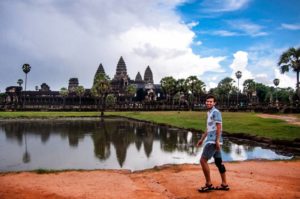An Earth scientist and a mental health expert take Stanford students to explore how food, water and conflict have shaped a troubled country
What we wanted to accomplish in the class was to have the students recognize the full suite of social, economic and political factors that go along with science and technology to meet the challenges of the developing world.– Scott Fendorf
While most Stanford students who study overseas are based in developed locales, one program in 2015 challenged participants to learn from Cambodia’s struggle to emerge from war trauma and neglect.
Scott Fendorf, a professor of Earth sciences, and Daryn Reicherter, clinical associate professor of psychiatry and behavioral sciences at the Stanford School of Medicine, brought students to Cambodia to explore the relationships among food, water and social conflict there.
Together, Reicherter and Fendorf led an unusual program that exemplified Stanford’s Bing Overseas Studies Program’s interdisciplinarity and rigor.
Each scholar has done research in Cambodia for more than a decade. Reicherter studies how trauma from the war in Indochina and the Khmer Rouge regime continues to affect mental health. Fendorf turned to Cambodia as a case study in how geology can adversely affect water quality and therefore food production. Because instability left Cambodia less developed than its neighbors, he was able to see there how certain geological features enable naturally occurring arsenic to leach into groundwater.

Their program started on the Stanford campus with a quarter-long course on the social and ecological forces shaping today’s Cambodia. Participants learned how water issues and food scarcity have sparked conflict throughout history, from the Angkor Empire to the 20th century.
In Cambodia, they saw sobering sights but also the country’s work toward healing. Students met with lawyers of the Khmer Rouge genocide tribunals. They saw communities’ efforts to promote safety, including access to safe drinking water. They experienced the nuts and bolts of Cambodia’s rebuilding by helping a local family drill a well.
It’s one thing to learn about soil chemistry in a classroom, it’s a totally other thing to drill a well 60 meters down by hand and see the soil change colors. The darker the grey, the more arsenic was trapped in the soil there. – Aitran Doan, ’18
Through a blend of experiential and classroom learning, they discovered how science and history, data analysis and thoughtful compassion can unite toward solving tough problems.
The solutions, in terms of science, are all there. It’s about how to heal the community. – Arjun Krishnaswami, ’16
Learn more about the sojourn in Cambodia, including a podcast in which students and faculty expand on their experiences.
Explore the many offerings in Stanford’s Bing Overseas Studies Program.
